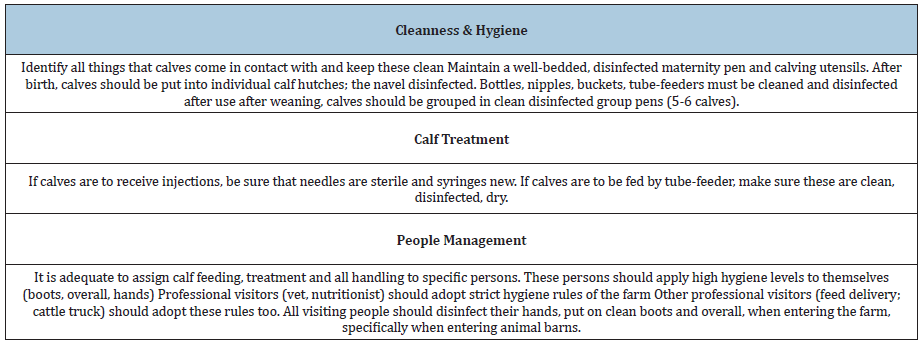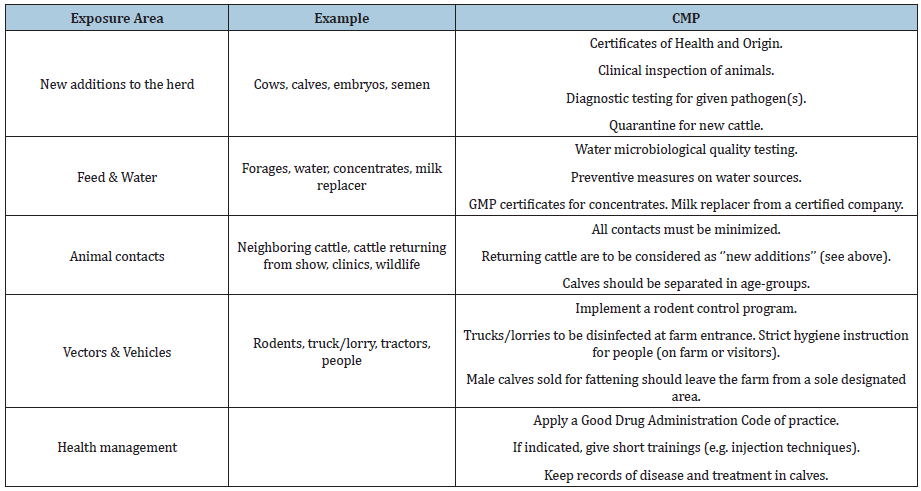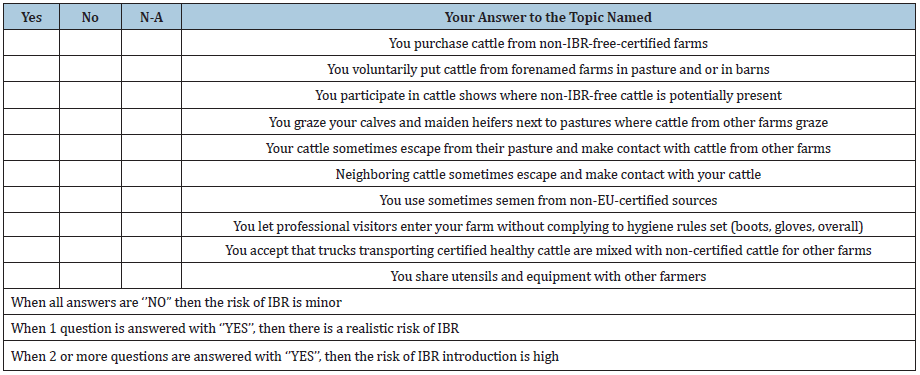- Submissions

Full Text
Approaches in Poultry, Dairy & Veterinary Sciences
Biosecurity Protocols A Dairy Farm Management Tool for Protecting Calves Health
Jos Noordhuizen*
Former Diplomate
*Corresponding author: Jos Noordhuizen, Former Diplomate, France
Submission: March 11, 2021;Published: March 25, 2021

ISSN: 2576-9162 Volume8 Issue2
Introduction
Optimal calf health on dairy farms is an essential factor for safeguarding the animal for future health and productivity. After all, the calves are the investment for the future of the dairy farm Brand et al. [1] Given the fact that a calf is born as an immune-naïve animal, vulnerable to disease, the dairy farmer should do everything to keep the calf healthy and to maintain a steady daily growth rate so that as an adult cow it will have an optimal productivity and reproductivity as well as optimal welfare Dietrich [2]. A great variety of pathogens is present on the average dairy farm, sometimes originating from adult cattle, from pet animals or birds, sometimes from neighboring ruminants including wild-life, or from humans. In the latter case, professional visitors such as the claw trimmer, the veterinarian, the nutritionist and salesmen play a potential role in pathogen transfer. To deal with this variety of factors contributing to health impairment of calves, the dairy farmer needs to have an overview of these factors and their impact, as well as of the means to reducing the risks of disease transfer. Biosecurity Protocols have been developed to assist the dairy farmer in reducing these risks. This paper deals with the different factors contributing to disease transfer and the applicable biosecurity management protocols.
Pathogen/Infection transfer
Pathogens can be transferred through various routes. Table 1 shows the most important routes, without being exhaustive. For example, Salmonella spp can be found in pasture, forages irrigated with contaminated water, rats and mice, and water sources (also Neospora, E. coli and Cryptosporidium spp). Neospora and BVD virus can even be transferred by healthy but infected animals. Wildlife such as squirrels, foxes and deer may be infected with Brucella spp, Leptospires, Salmonella spp, and E. coli). Insects may transfer Anaplasmosis or Blue Tongue. The enormous variety of pathogens and their hosting species makes the approach to animal health a complex one. From Table 1 it appears further that overall hygiene, separation (animal age groups and lactation groups) and quality requirements on feedstuffs and drinking water are paramount in combatting infection transfer on the dairy farm.
Table 1: Overview of major pathogen transfer routes.

General management measures
In order to give a foundation to the Biosecurity Protocols it is strongly advised to implement general management measures. These measures assist in adopting the most adequate mentality and attitude on the dairy farm for controlling diseases. Table 2 provides an overview of relevant general management measures. With regard to the third domain in Table 2, it could be envisaged to install large billboards at the farm entrance, pointing the visitors to the rules to comply to when entering that farm. A specifically designated parking place for (professional) visitors should be considered. This too may cut off an infection transfer route.
Table 2:An overview of general management measures.

Biosecurity protocols
A biosecurity program is like an assurance policy for animal health and productivity; in neither of them the zero-risk does exist. Moreover, it is quite common that the implementation of a biosecurity program is less costly than having several diseased animals Noordhuizen [3]. Together with the farmer or farm manager, the veterinarian can take the lead in developing a biosecurity program.
Biosecurity programs are based on three pillars:
a) An analysis of the prioritized prevalent and potential threats (infections) and risks.
b) The management of these risks.
c) The communication about the risks (explaining to employees; need of compliance)
Analysis of threats and risks
The farmer and veterinarian discuss about the major threats (infections) present on or expected for the dairy farm. In this context this paper will not elaborate on cheese-making farms for reasons of simplicity. It could be worthwhile to identify first whether the farm produces milk or animals (culled cattle; sold calves) too. Let us assume for simplicity reasons that the farm produces milk only. Then, it should be established which are the most prevalent diseases on the farm needing attention and which other non-prevalent diseases might become a real threat and, hence, should be prioritized too. This yields a short list. An example shortlist may comprise the most important mastitis pathogen (e.g. Staph. aureus) on the farm, combined with Mortellaro disease and BVD. The following step is to determine by which routes these pathogens enter the farm, how they survive and are possibly shed by the animals. Noordhuizen provides an exhaustive overview of transmission routes. Next step is to identify the most relevant risk factors contributing to the occurrence of these diseases and assess their respective impact (minor; moderate; high). When no information on impact is available from literature, the veterinarian can make a qualitative assessment of the risk factor impact. Then the biosecurity program can be further developed.
Developing the biosecurity program
The sound foundation of a biosecurity program is the implementation of “general management measures’’. Foundation because these measures may adjust management attitude and mentality, as well as that of farmworkers. As addressed before, the biosecurity program is further based on the analysis of threats (hazards or diseases) and their associated risk factors. This analysis results in the definition of ‘’critical management points’’. Examples of such Critical Management Points (CMP) are presented in Table 3. CMP should be adapted for the individual farm regarding applicability and ease of understanding. Limiting the animal movements onto and within the farm, as well as limiting possible contacts between animals on one side and vehicles/vectors/people on the other side represent important control measures in biosecurity. Separation of cattle in different management groups, such as fresh cows, midlactation, end-lactation, dry cows, but also in calf-age groups means that each group is an epidemiological management unit. Contacts between groups must be avoided. Management should be adapted to the specificities of each group individually. Epidemiologically spoken, it is not necessary to control all risk factors for a disease. Given the commonly multifactorial nature of diseases in ruminants, it is sufficient to eliminate or reduce the impact of several relevant risk factors to get rid of a disease.
Table 3: An example of Critical Management Points (CMP) on a dairy farm.

GMP = produced under a good manufacturing code of practice.
Prevention
With regard to prevention, Noordhuizen [4] presents a listing of 93 management measures contributing to prevention of occurrence of infectious diseases. These measures can be regarded as being an essential part of a Good Dairy Farming Code of Practice. Most of the measures are well-known but now compiled into one practical document. Examples of measures are the routine monthly scoring of body condition in dry cows and fresh cows; the recalculation of feed rations for calves at each feed change; checking growth rate in older calves at least twice yearly; checking housing hygiene weekly; checking barn climatic conditions daily.
When a calf is removed from a hutch: *put the hutch outside in a designated cleaning area.
a) Remove straw, manure and dirt.
b) Clean it with high pressure water.
c) Disinfect, rinse and let the hutch dry in the air.
When young calves are being fed, they should be checked routinely on clinical signs of illness; findings should be noted on a scoring card. Severely affected calves should be separated from group mates and put in a separate sick-pen. Treatment should be recorded and follow a Calf Treatment Advisory Plan, designed by the veterinarian. The veterinarian may draw Checklists for the individual dairy farm, which may assist the farmer in his awareness of risks on his farm. Table 4 presents a self-assessment farmer’s checklist for assessing the risk level for Infectious Bovine Respiratory disease (IBR, BHV-1). For young calves particular checklists can also be developed. A short example is given in Table 5. One may deduce from this Table 5 that the better the hygiene and the better the management quality, the lesser the calves will be at risk of diseases such as respiratory disease or diarrhea.
Table 4:Anternal farmer’s checklist for assessing the risk of IBR on a dairy farm.

(source: Noordhuizen [3]). N-A means not applicable.
Table 5:Part of a Checklist for scoring management practices in young calf rearing.

Concluding discussion
From the text above it should be clear that herd veterinarians could play a paramount role in developing and implementing Biosecurity Programs. He/she can assist the farmer in his efforts to set up the biosecurity program on the farm. The veterinarian could, in that context, be considered as a coach for the farmer and the farmworkers. The changes to be made on a dairy farm in the context of a biosecurity program do, in general, not require large investments while the benefits of improvement are high. The appropriate, successful implementation of such a program depends on the proper understanding of the relevance and the benefits produced, as well as on the compliance. The herd veterinarian also plays a role in the communication process on the farm. When deemed necessary, the veterinarian can develop short hands-on training sessions for specific issues within the program for specific farmworkers Dickrell [5]. An example is a training on ‘’Appropriate Colostrum Feeding’’.
A biosecurity program is not a panacea, functional on all farms at the same time; moreover, it must be tailor-made for each individual farm. This is the only way in which costs and benefits can be assessed in a reasonable manner. Noordhuizen [4] provides a chapter on Biosecurity, including an eight-pages farm checklist for assessing biosecurity status on a dairy farm. This chapter includes the following sections: Farmer statements; keeping infectious diseases off the farm; use of strategic vaccinations; biosecurity & calf management; testing in biosecurity programs; biocontainment controlling disease problems in cattle groups; role of equipment; sanitation; evaluation procedures on biosecurity status. Finally, it can be stated that a biosecurity program can most easily be an extension of an on-going herd health and productivity management program on the dairy farm, mainly because several issues addressed in the forenamed Tables are also part of these herd health and productivity management programs. The difference might be in the organization and structuring of biosecurity actions, management measures and checklists in protocols.
References
- Brand A, Noordhuizen JPTM, Schukken YH (2002) Herd health and production management in dairy practice. (2nd edn), Wageningen Academic Publishers, Wageningen, Netherlands.
- Dietrich A (2015) At dairyherd.com
- Noordhuizen J (2012) Dairy herd health and management (a guide for veterinarians and dairy professionals). Context Products Ltd, UK, p. 465.
- Noordhuizen J (2021) Managing cold stress in young dairy calves: a review. Archives of Veterinary and Animal Sciences 3 (1):
- Dickrell J (2019) At dairyherd.com
© 2021 Jos Noordhuizen. This is an open access article distributed under the terms of the Creative Commons Attribution License , which permits unrestricted use, distribution, and build upon your work non-commercially.
 a Creative Commons Attribution 4.0 International License. Based on a work at www.crimsonpublishers.com.
Best viewed in
a Creative Commons Attribution 4.0 International License. Based on a work at www.crimsonpublishers.com.
Best viewed in 







.jpg)






























 Editorial Board Registrations
Editorial Board Registrations Submit your Article
Submit your Article Refer a Friend
Refer a Friend Advertise With Us
Advertise With Us
.jpg)






.jpg)














.bmp)
.jpg)
.png)
.jpg)










.jpg)






.png)

.png)



.png)






